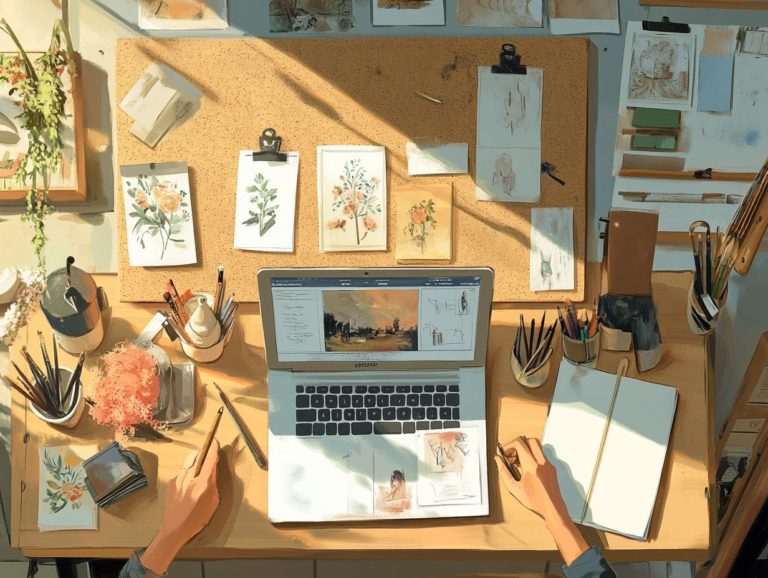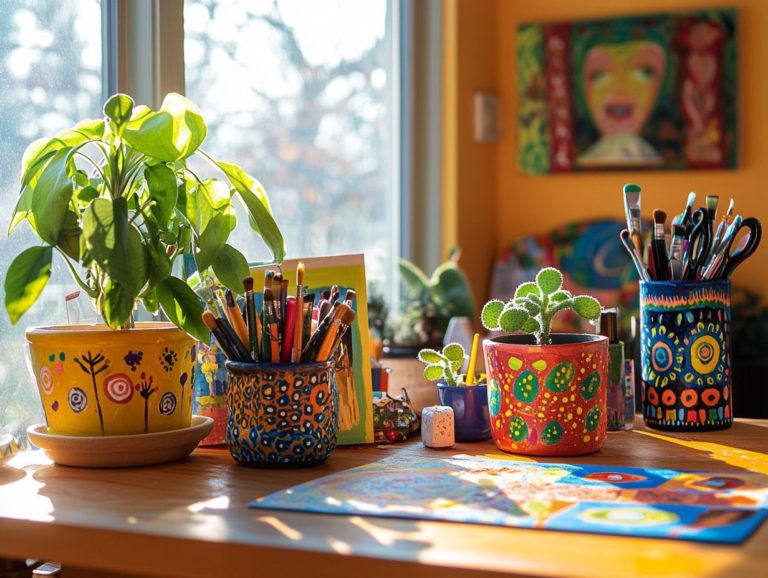The Role of Imagination in Creative Processes
Imagination serves as the spark that ignites your creativity, acting as both the foundation and the driving force behind your artistic pursuits.
This article delves into the intricate relationship between imagination and creativity, meticulously breaking down the creative process into distinct stages. It showcases how imagination enhances each stage.
You ll discover practical techniques to cultivate your imaginative thinking while addressing the common blocks that can stifle your creative flow.
Get ready to unlock your imaginative potential and take your creativity to new heights!
Contents
- Key Takeaways:
- Understanding Imagination
- The Creative Process
- Imagination and Creativity
- The Relationship Between Imagination and Creativity
- How Imagination Enhances Creative Processes
- Examples and Case Studies
- Cultivating Imagination for Creativity
- Practical Techniques and Exercises
- Overcoming Blocks to Imagination
- Frequently Asked Questions
- What is the role of imagination in creative processes?
- How does imagination impact the quality of creative work?
- Can imagination be learned or developed?
- Why is it important to nurture imagination in children?
- How can one use imagination to overcome creative blocks?
- Are there any downsides to relying too heavily on imagination in creative processes?
Key Takeaways:

Unlock your imagination to fuel your creativity!
The stages of creativity including preparation, incubation, illumination, and verification are all fueled by imagination.
Cultivating imagination through exercises and techniques can enhance creativity and lead to innovative solutions.
Understanding Imagination
Understanding imagination is a journey to understand its meaning and importance in various fields, from childhood development to professional innovation.
Imagination serves as the catalyst for creative thinking, allowing you to envision possibilities that extend beyond immediate reality. It plays a crucial role in emotional regulation and mental health, profoundly influencing your behavior and thought processes.
Neuroscience research reveals that the limbic system, which controls emotions, and the prefrontal cortex, involved in decision-making and planning, are essential for unlocking creativity. This underscores the transformative power of imagination in both personal and collective contexts.
Defining Imagination and its Importance
Imagination is your gateway to forming new images and concepts in your mind, serving as a foundation for both creativity and innovative ideas. This captivating cognitive process allows you to explore possibilities beyond your immediate reality, creating a unique interplay between thought and emotion.
Psychologically, it serves as a mental playground where you can navigate different scenarios, enhancing your problem-solving skills. By picturing various outcomes, you engage in creative thinking that can lead to breakthroughs in countless fields, whether in the arts or sciences.
Your imaginative capabilities play a vital role in emotional regulation, providing a sanctuary for you to process feelings by envisioning different perspectives. This ultimately fosters resilience and adaptability as you navigate challenges.
The Creative Process
The creative process is a flexible journey that guides you from generating ideas to implementing them.
Here, creative thinking stands as the bedrock of innovation, giving you the power to explore and realize your visions with clarity and purpose.
Exploring the Stages of Creativity
Exploring the stages of creativity means understanding how to generate fresh ideas, starting from that initial spark of inspiration all the way to the final execution of innovative concepts.
To navigate this intricate journey, you need to adopt a mindset that fosters divergent thinking, allowing a rich array of possibilities to surface during the brainstorming phase. This initial step is essential as it lays the groundwork for the refinement stage, where your ideas begin to take shape through careful evaluation and critical analysis.
By embracing unconventional approaches, every phase from drafting rough sketches to crafting polished prototypes has the potential to thrive.
When you view challenges as opportunities and stay open to those serendipitous moments of clarity, you can ultimately turn your ideas into amazing realities that captivate and inspire!
Imagination and Creativity

Imagination and creativity are intricately intertwined, with imagination acting as your mental playground a space where creative thoughts flourish and ideas can be explored in depth.
Embrace this interplay, allowing your mind to wander freely and discover the potential that lies within.
The Relationship Between Imagination and Creativity
Imagination and creativity are deeply connected. Imagination unlocks your creative potential and nurtures various forms of creativity.
When you tap into your imaginative capabilities, you uncover innovative solutions to problems in art, science, and everyday life.
For instance, envisioning vibrant worlds allows a writer to transform ideas into captivating narratives. A scientist can conjure groundbreaking theories by visualizing uncharted concepts.
Unlocking your imagination fosters a fluid exchange of ideas. This paves the way for unexpected collaborations and inventions, like the smartphone, which revolutionized communication.
By embracing the power of imagination, you elevate your artistic expression and contribute to the grand tapestry of human innovation.
How Imagination Enhances Creative Processes
Imagination elevates creative processes. It acts as a transformative force that fosters mental growth and deepens engagement with artistic endeavors.
Examples and Case Studies
Numerous examples illustrate how imagination fuels creativity. Notable figures like Bruce Black and Steve Jobs exemplify the power of innovative thinking.
Bruce Black, a visionary in digital design, harnessed his imaginative prowess to revolutionize user experiences. His work shows how envisioning an alternative reality can yield compelling solutions.
Steve Jobs also demonstrated that imagination transcends mere idea generation. He envisioned the profound impact of his ideas on daily life. The creation of the iPhone was a revolutionary leap that redefined communication and interaction.
These case studies show that creativity flourishes when imagination is embraced and nurtured.
Cultivating Imagination for Creativity
Cultivating imagination for creativity requires engaging in practical techniques. These methods create an environment that fosters daily creativity and innovation.
By adopting these techniques, you can unlock your creative potential and inspire a continuous flow of fresh ideas.
Practical Techniques and Exercises

Practical techniques like visualization and mind mapping can elevate your imaginative thinking. Engaging in these exercises unlocks new levels of creativity.
Visualization helps you craft vivid mental images. This technique is instrumental in solving complex problems or generating innovative concepts.
Mind mapping organizes your thoughts visually. It promotes connections between seemingly unrelated ideas.
Both techniques encourage lateral thinking, essential for a rich inner world. Regular practice sharpens cognitive abilities and establishes a habit of imaginative exploration, enhancing personal and professional endeavors.
Overcoming Blocks to Imagination
Overcoming blocks to imagination is crucial for unlocking creativity. These barriers often stem from emotional challenges, stress, and a lack of supportive individuals around you.
Identifying and Addressing Barriers to Imagination
Identifying and addressing barriers to your imagination is essential for enhancing both your emotional and mental health. It ultimately paves the way for improved problem-solving abilities.
You may face obstacles like fear of judgment or a lack of time. Societal pressures can also stifle your creative thinking.
Create a safe environment, whether at home or in the workplace. This can be incredibly beneficial for overcoming these challenges.
Encourage open dialogue and collaboration. This way, everyone can easily share ideas without fear of criticism.
Don’t forget to schedule regular breaks from your routine! It can help rejuvenate your creative spirit.
Try exploring different artistic forms! Activities like writing and painting can spark your imagination.
Frequently Asked Questions
What is the role of imagination in creative processes?
Imagination plays a crucial role in creative processes. It allows individuals to think outside the box and come up with unique ideas and solutions.
How does imagination impact the quality of creative work?
Imagination can greatly impact the quality of creative work. It enables individuals to bring original and innovative ideas to the table, making the work stand out and be more impactful.
Can imagination be learned or developed?
Yes, imagination can be learned and developed through techniques like brainstorming, visualization, and experimentation.
Why is it important to nurture imagination in children?
Nurturing imagination in children is vital. It helps them develop problem-solving skills, creativity, and critical thinking, all essential for future success.
How can one use imagination to overcome creative blocks?
Imagination helps overcome creative blocks. It allows individuals to see things from a different perspective and come up with new solutions and ideas.
Are there any downsides to relying too heavily on imagination in creative processes?
While imagination is integral to creative processes, relying too heavily on it can lead to unrealistic ideas and impractical solutions. It’s important to find a balance between imagination and practicality for successful outcomes.







